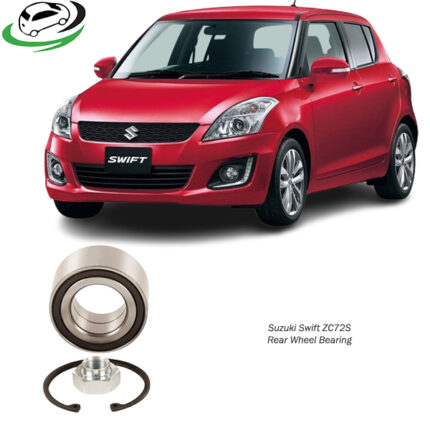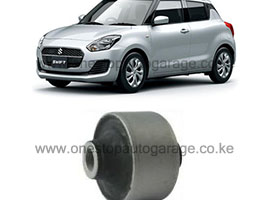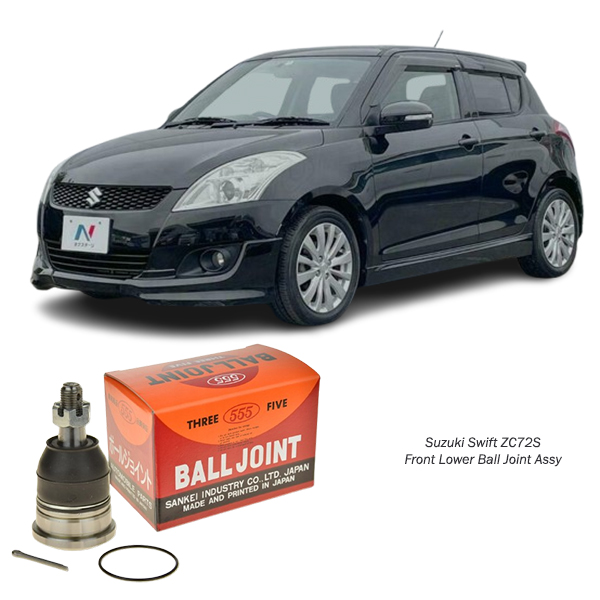-17%
Get Suzuki Swift ZC72S Front Lower Ball Joint Assy SBS012 in Kenya
The front lower ball joint assembly is an essential component of a vehicle’s suspension system. Acting as a pivot point between the wheel and the suspension, it plays a vital role in ensuring smooth steering, stability, and proper wheel alignment. This detailed guide will explore the structure, function, benefits, maintenance, and replacement of the front lower ball joint assembly, highlighting its importance in vehicle safety and performance.
What is a Front Lower Ball Joint Assembly?
A ball joint assembly is a spherical bearing housed in a socket, resembling a human hip joint in its design and functionality. The front lower ball joint assembly specifically connects the lower control arm to the steering knuckle, allowing the wheel to move in multiple directions while supporting the vehicle’s weight.
The assembly typically consists of:
- Ball Stud: A steel shaft with a spherical head that pivots within the socket.
- Socket: The housing in which the ball stud rotates.
- Boot or Dust Cover: A rubber or plastic cover that seals the joint, preventing dirt and moisture from entering while retaining grease.
- Grease: Lubricant inside the joint to minimize friction and wear.
The front lower ball joint assembly is designed to handle both vertical and lateral forces, making it a crucial part of the suspension system.
Functions of the Front Lower Ball Joint Assembly
- Allows Suspension Movement
The ball joint acts as a pivot point, enabling the suspension to move up and down. This flexibility allows the vehicle to absorb shocks from uneven road surfaces, ensuring a smooth ride. - Enables Steering
The ball joint facilitates the rotation of the steering knuckle, allowing the wheels to turn as the driver steers. This is critical for precise handling and control. - Supports Vehicle Weight
In many vehicles, the front lower ball joint bears a significant portion of the vehicle’s weight, making it essential for maintaining stability and balance. - Maintains Wheel Alignment
A properly functioning ball joint ensures that the wheels remain aligned during movement. Misalignment caused by a worn or damaged ball joint can lead to uneven tire wear and poor handling.
Types of Front Lower Ball Joints
Ball joints can vary depending on the vehicle type and design:
- Load-Carrying Ball Joints
These ball joints support the weight of the vehicle and are typically found on the lower control arm. They also pivot to allow steering movement. - Follower Ball Joints
These ball joints primarily assist in steering and do not bear the vehicle’s weight. They are often located on the upper control arm in double-wishbone suspension systems. - Non-Serviceable Ball Joints
Modern vehicles often come with sealed, non-serviceable ball joints that are pre-greased during manufacturing. These must be replaced when worn out. - Serviceable Ball Joints
Older vehicles and some heavy-duty applications use serviceable ball joints with grease fittings, allowing periodic lubrication to extend their lifespan.
Signs of a Faulty Front Lower Ball Joint Assembly
A worn or damaged ball joint can compromise the vehicle’s safety and performance. Common signs of a failing front lower ball joint include:
- Clunking Noise
A loose or worn ball joint may produce clunking or knocking noises when driving over bumps or during turns. - Uneven Tire Wear
A damaged ball joint can cause improper wheel alignment, leading to uneven tire wear, especially on the inner or outer edges. - Vibrations in the Steering Wheel
Excessive play in the ball joint can result in vibrations or wobbling felt through the steering wheel. - Poor Handling
A faulty ball joint can cause the vehicle to feel unstable or drift to one side, especially during turns. - Visible Damage
Inspecting the ball joint may reveal a torn dust boot, rust, or excessive wear on the joint.
Importance of Maintaining the Front Lower Ball Joint Assembly
Proper maintenance of the ball joint assembly is crucial for several reasons:
- Safety
A failing ball joint can compromise vehicle control, increasing the risk of accidents. In severe cases, a broken ball joint can cause the wheel to detach from the suspension. - Performance
A healthy ball joint ensures smooth steering and suspension movement, contributing to a comfortable and responsive driving experience. - Cost Efficiency
Timely maintenance and replacement of ball joints can prevent further damage to the suspension system, saving on costly repairs in the long run. - Tire Longevity
Properly functioning ball joints help maintain wheel alignment, reducing uneven tire wear and extending tire life.
Maintenance Tips for Front Lower Ball Joint Assembly
- Regular Inspections
Check the ball joint for signs of wear, such as looseness or damage to the dust boot, during routine vehicle maintenance. - Lubrication
For serviceable ball joints, apply fresh grease at recommended intervals to minimize friction and wear. - Avoid Overloading
Excessive weight can accelerate ball joint wear. Ensure the vehicle is not overloaded beyond its specified capacity. - Replace in Pairs
When replacing a worn ball joint, it’s often advisable to replace the corresponding joint on the other side to maintain balanced performance.
Replacing the Front Lower Ball Joint Assembly
Replacing a ball joint requires specialized tools and mechanical expertise. The steps typically involve:
- Lifting the Vehicle
Securely raise the vehicle using a jack and place it on jack stands for safety. - Removing the Wheel
Remove the wheel to access the ball joint and suspension components. - Separating the Ball Joint
Use a ball joint separator or similar tool to disconnect the ball joint from the steering knuckle. - Removing the Old Ball Joint
Depending on the design, the ball joint may be pressed, bolted, or riveted to the control arm. Use the appropriate tools to remove it. - Installing the New Ball Joint
Install the new ball joint, ensuring it is securely fastened according to the manufacturer’s specifications. - Reassembling and Testing
Reattach the steering knuckle, reinstall the wheel, and test the vehicle to ensure proper operation.
Benefits of a High-Quality Front Lower Ball Joint Assembly
- Enhanced Steering Control
A well-functioning ball joint provides precise steering, improving driver confidence and vehicle handling. - Improved Ride Comfort
Smooth suspension movement contributes to a comfortable ride, even on rough terrain. - Extended Suspension Life
High-quality ball joints reduce stress on other suspension components, extending their lifespan. - Better Tire Performance
Proper alignment and balanced movement result in even tire wear and optimal traction. - Increased Safety
Reliable ball joints minimize the risk of suspension failure, ensuring a safe driving experience.
Conclusion
The front lower ball joint assembly is a critical component that plays a pivotal role in a vehicle’s suspension system. By connecting the control arm to the steering knuckle, it ensures smooth steering, stable suspension movement, and proper wheel alignment. Regular maintenance and timely replacement of the ball joint assembly are essential to preserving vehicle performance, safety, and efficiency. Whether you’re a daily commuter or an off-road enthusiast, investing in a high-quality front lower ball joint assembly ensures a smoother, safer, and more enjoyable driving experience.
Follow us on Facebook for more parts.



